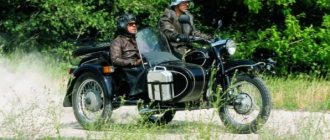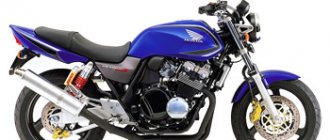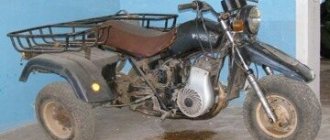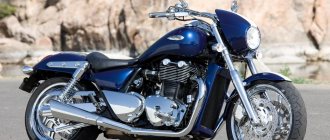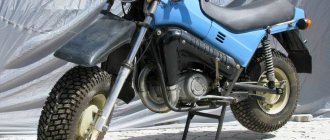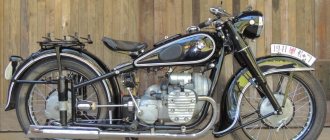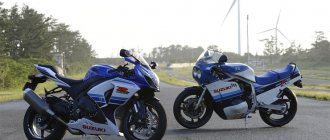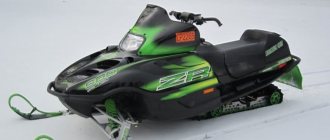Today we will tell you about the history of the formation of one of the most recognizable motorcycle brands of our time - KTM.
It all started with a small metal processing company called Kraftfahrzeuge Trunkenpolz Mattighofen (KTM), founded in 1934 in Mattighofen by engineer Hans Trunkenpolz. Even before the war, the talented inventor and racer began selling DKW motorcycles and even became an Opel dealer. At that time, his company employed only five people.
The next stage of KTM development began in 1943, when Hans Trankenpolz returned from the fields of World War II to repair trucks and engines for the war effort. At this time, 35 workers were already working under his leadership. Feeling a lack of spare parts to do his job, the engineer soon organized his own production. And it all could have ended there back in the late 40s, when demand for KTM services declined sharply. However, the experienced Hans Trankenpolz caught the spirit of the times, which required inexpensive but fast means of transportation.
Assembly Features
What are the features of KTM bicycles? Reviews from owners confirm that components from the best manufacturers are used to assemble such bikes:
- DT Swiss or Shimano hubs;
- cranks and carriages - exclusively Shimano;
- contact pedals for specialized Shimano shoes, standard design pedals – Wellgo;
- V-brake and disc brake systems – Shimano;
- seatposts, handlebars, stems - OEM or Ritchey.
A brief excursion into history
The KTM company was founded back in 1934.
It was at this time that the talented Austrian engineer Hans Trunkenpolz decided to organize his own workshop, which would specialize in metalworking. The company was named Kraftfahrzeuge Trunkenpolz Mattighofen, or KTM for short. For several decades, the young company's employees worked tirelessly to develop technological innovations. By 1954, the once cottage industry had transformed into a thriving racing motorcycle business. 10 years have passed, and the company presented its first bicycle model to the public.
In 1971, successful Austrian cyclist Walter Obersberger won the road racing championship using KTM bicycles. Subsequently, the athlete never gave up using bikes of this brand, climbing to the podium a record 130 times.
In the early 2000s, KTM (bicycles) underwent a major transformation. The company's assortment now includes innovative mountain models that meet the latest standards, as well as hybrid models for extreme disciplines.
Today, the world's most famous bicycle manufacturers use innovative solutions that were successfully used by the company's engineers at the end of the last century. In turn, the Austrian company does not stop there, remaining a leading generator of ideas on the market for the production of modern bikes.
The first KTM motorcycles
Hans Trankenpolz bought his first motorcycle engine in the city of Günskirchen. It was a 98cc Rotax engine with a recoil starter. And by 1953, he was launching the production of his first motorcycle called the KTM R 100. Every day his workers assembled 3 units, which were simply in great demand. The success of the enterprise attracted the attention of influential businessman Ernst Kronreif, who bought a controlling stake in the production. At this time, the company acquired the name Kronreif & Trunkenpolz Mattighofen (it was decided not to change the recognizable abbreviation). In the same year, KTM entered their R100 into the national racing championship, where it was among the winners in the 125 cc class. cm.
This gave a strong impetus to the development of production. By the end of the fifties, KTM bikes, of which there were already half a dozen in the line, were known throughout Germany as inexpensive but very high-quality machines. Since 1959, the company begins producing scooters.
City bikes
So, which models from a reputable brand, designed for movement in urban landscapes, deserve consumer attention?
- Country Sport is an excellent option for riding on the streets and traveling short distances outside the city. The model is equipped with wide tires, which open up the possibility of driving on rough terrain. An effective front shock absorber helps absorb shock loads on the front axle. Equipping the bike with components from leading manufacturers makes it possible to use the model as a touring bike.
- Life Time is a typical, easy-to-use city bike. An 8-speed planetary hub combined with narrow 28″ wheels ensures the most comfortable ride. The model is ideal for everyday riding in the city.
- Life Sprint is an ideal solution for those who want to quickly move around the metropolis. The hybrid model is highly maneuverable, which becomes indispensable in heavy traffic. The design of the bicycle is in many ways similar to the previous one. The difference is the removal of weighting components.
- City Fun is a model for cyclists who prefer a leisurely ride through parks. The city bike is convenient for everyday use and easy to maintain. The bicycle is equipped with a hub for 3 gears and has a foot brake. The factory equipment includes a rack, lights and fenders.
History of the KTM automobile brand
The brand name is usually similar to the name of its founder. The history of the KTM motorcycle brand is proof of this fact. In the original name of the brand, Kraftfahrzeuge means car, Trunkenpolz means the surname of the founder, Mattighofen means the city where the workshop is located.
The official year of foundation of the company is 1934. For the first few years of its existence, the company operated in one direction - metal processing.
Hans Trunkenpolz, who stood at the origins of the future corporation, was 25 years old. The young man’s talent manifested itself not only in work. He rode motorcycles expertly and competed successfully in cross-country racing.
Hans Trunkenpolz - founder of KTM
The history of the KTM brand can be divided into several stages.
- Metal processing only (1934-1937).
- Dealership and the beginning of team formation. The first 5 people began working under the leadership of Hans (1937-1943). The workshop receives a new status as a dealer for DKW motorcycles. By 1938, the company occupied a leading position in the provision of repair services to the population of Upper Austria. The outbreak of war made adjustments to the life of the inventor’s family. The man went to work, and the management of the workshop was transferred to the hands of his wife. The young woman successfully completed the task until her husband returned.
- On behalf of the military leadership, Hans begins a new activity in the repair of military equipment. His company already employs 35 people.
- At the next stage, the production of parts begins in the workshop; by 1948, 2 production workshops were opened. With the growth of production, new jobs appeared. The number of employees has doubled.
- A new stage in the development of the future KTM brand began in connection with the crisis and the fall in demand for car repair services. It was 1953. The search for new opportunities led Hans to create fast, light, comfortable and affordable means of transportation for the general population - motorcycles.
- In 1955, changes took place in the company's management structure. Ernst Kronreif becomes its co-owner. He buys a large share of the shares. Adjustments are being made to the company name. Now it sounds like this: Kronreif & Trunkenpolz Mattighofen. But the KTM abbreviation itself remains the same.
- The period from 1960 to 1980 is the active phase of the company's growth, when its products gain widespread popularity and worldwide recognition.
- The 80s brought dramatic changes to the development of the company: first, the main shareholder, Ernst Kronreif, died, and 2 years later, its founder died. The company now belonged to the son of its founder, Erich. He returns his former name, but this does not save him from bankruptcy.
- The nineties became a difficult period for the legendary company in the fight against the crisis. A division of the large auto and motorcycle giant into 4 separate companies followed.
- The two thousand years are a new history of the KTM brand.
Production of KTM products
In 2021, the motorcycle brand became the best-selling motorcycle brand outside Asia.
Manufacturer country
The KTM Corporation, which has become a world-famous brand, was built in the center of Europe - the Republic of Austria. Changes in the country's economy had an impact on its citizens, especially those involved in manufacturing.
Economic growth in one niche (industry) caused a decline in another (repair work).
The retraining of the enterprise from an automobile repair shop to the production of motorcycles allowed Hans Trunkenpolz not only to remain on the market, but also to reach a new level.
KTM is a world-famous manufacturer of reliable sports motorcycles, as well as mopeds, bicycles, and supercars.
First KTM models
The first models of KTM motorcycles featured a tiger as their logo.
Evolution of the KTM logo
Released in the early 50s, the R100 models had a 98cc Rotax engine with a recoil starter. Every day the company assembled 3 motorcycles, which were immediately sold out.
The first motorcycle of the KTM brand – model R100
In 1953, the company entered its first model into the national championship races, where it was among the winners. This became an incentive for increased production, popularity and the launch of a new model.
Mountain bikes
KTM bicycles of this class are in significant demand in the domestic market. Such bikes are suitable for high-speed riding on country roads, trips into nature, riding in rough terrain, and participating in competitions at the amateur level. Next, we’ll look at the most popular KTM mountain bikes.
- Ultra Force 29 is a model praised by both off-road enthusiasts and novice cyclists. Larger wheels, a technologically advanced frame, reliable disc brakes, and an effective suspension fork - all this allows you to achieve high results in competitions and stand out among your peers. KTM (bicycles) of this series are extremely light, reliable, rolling and therefore are one of the best solutions for experienced cycling enthusiasts.
- Ultra LTD 27 is an anniversary model, decorated in a strict matte black color with aggressive orange accents. The bike is equipped with equipment from the reputable SLX brand and an effective suspension fork from Reba RL. Ideal for beginner athletes.
- The Ultra One 29 is KTM's most popular model in the mountain bike category. The sample is distinguished by a relatively low price and is equipped with high-quality equipment from leading manufacturers. The main advantage of the bike is its reliable assembly and careful attention to every detail. Therefore, many call the model the best solution for those who are looking for a balance between attractive design and good assembly.
KTM now
Ernst Kronreif died in 1980, and Hans Trankenpolz died two years later. The company was headed by Hans' son, Erich, who changed the name to Kraftfahrzeug Trunkenpolz Mattighofen. This was not the most successful period in the company's history. Despite a number of interesting technological solutions in the mid-80s, it soon goes bankrupt.
In 1992, KTM became completely insolvent and was divided into three companies, of which only KTM Sportmotorcycles GmbH (from 1994 - KTM Sportmotocycles AG) continued to produce motorcycles. Throughout the 90s. the company slowly emerged from the crisis, gradually regaining lost ground. In 2000, the company presented the prototype of the first motorcycle with a liter engine, and in 2004, models such as the 990 RC8 Venom and 990 Super Duke were released. The popularity of the latter finally returned the company to the world TOP.
In 2005, the motorcycle manufacturer entered the Russian market, where there were many fans of the brand. Having finally overcome the consequences of the crisis, the company already produces 135,000 motorcycles a year. The success inspired KTM engineers. In 2006, their products became winners at all stages of the Dakar Rally, and 4 years later, the Austrian company won all the world motocross championship titles.
Today it is a rare motorcycle enthusiast who does not know about KTM products. Of particular interest is the company's current flagship, the 1290 Super Adventure, equipped with a 1300 cc engine.
Sports bikes
The Race Cross, Race Line and Race Comp models deserve special attention in this class.
These samples are developed on the basis of lightweight aluminum frames with butting technology. The steering glasses are reinforced with perforated gussets. The sports bikes of the presented series have a complete elegant design. All connections are carefully processed by grinding. At the same time, such processing of the seams does not at all affect the stability of the frame structure to increased mechanical loads.
Among other advantages, it is worth noting an impressive margin of safety with minimal weight. Therefore, such bikes demonstrate good rolling performance when riding on asphalt and dirt. In general, the above models can be characterized as bicycles with excellent equipment, noble design and a pronounced racing character.
International recognition
Period 1960-70s. was a bright page in the history of KTM. In 1964, a factory racing team was created, which in 1966 won three sets of gold medals in the international Six Days competition on the legendary KTM Comet bike. On the wave of popularity, just two years later the company conquered the American market with the Penton Six Days model.
In 1970, KTM engineers developed their own engine, which formed the basis of a powerful sports bike that became a three-time winner of the Motocross World Championship. By 1974, the KTM line already included 42 models.

